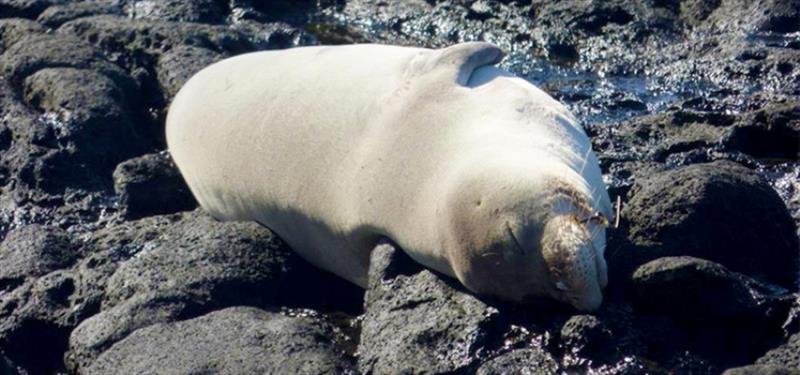
A tale of two hookings: RJ58 and RH48
by NOAA Fisheries 17 Feb 2018 19:57 UTC

RH48 sleeps soundly on the rocks despite the hook in her lip © NOAA Fisheries
Hawaiian monk seals may appear to have an easy life as they lounge on the beach. But everyday activities, including foraging for food, come with risks for seals sharing the waters with other ocean users.
For example, interactions with fishing gear can pose a serious threat to seals. While an external hook is not life threatening, several seals have died from internal damage done by ingested hooks. Even an external hook could lead to infection or disrupt normal foraging.
So, NOAA's monk seal emergency response team tries its best to remove hooks from seals whenever they are detected, but the task is not always straightforward. A couple of recent hooking incidents illustrate the difficulty and the risk assessment involved in trying to help Hawai'i's monk seals.
RH48 is a two-year-old female monk seal on the island of O'ahu with a large hook in the left corner of her mouth, which she got in late September 2017. NOAA and Hawai'i Marine Animal Response (HMAR) volunteers have been closely monitoring her since then, in hopes of safely capturing her and removing the hook.
Unfortunately, RH48 is sighted intermittently, and she prefers to haul out on rocky ledges, which make it unsafe for NOAA to try to capture her. The hook is not threatening RH48's health as it is external (not ingested), has no trailing line attached, and does not appear to be causing swelling or infection.
RJ58 ("Kaimana") is a yearling seal on O'ahu. On February 8, 2018, a concerned member of the public called the Marine Mammal Emergency Hotline to report that a monk seal had a fishing lure stuck in their lip. The HMAR volunteer network located and identified the seal as Kaimana.
It was too late for a safe response that night, so the HMAR team monitored the area throughout the weekend, until they finally spotted Kaimana hauled out at a sandy beach on Sunday afternoon. A NOAA team responded and safely restrained the seal, and then they removed the lure within minutes.
This is actually the second time this year that NOAA has removed a hook from Kaimana — they removed a circle hook from her lip in January 2018. Kaimana dislodged another lure herself in September 2017.
How is it that one seal is de-hooked twice in two months, and another has kept its hook for 5 months? It all comes down to risk assessment.
Prior to every seal intervention, NOAA personnel thoroughly evaluate the risks to both the seal and the response team. Each seal is evaluated based on body condition, injury severity, and behavior. The habitat is assessed for hazards to both seals and personnel. Rocks, boulders, and hard or slippery substrates can cause injury to both people and seals during response efforts.
Because Kaimana seems to favor sandy beaches, it has been relatively easy for NOAA personnel to safely remove the hooks she's encountered. On the other hand, NOAA staff have carefully evaluated RH48's haul out locations, and the risks associated with capturing her in these rocky areas far outweigh those associated with the hook.
Meanwhile, RH48 remains in excellent nutritional condition, there is no apparent swelling or infection from the hook, and the hook does not seem to be impeding her ability to feed or move around. We will continue to monitor RH48 and assess the hook and the feasibility and safety of capturing her. Should RH48 haul out in a safe, preferably sandy location, NOAA is prepared to respond as soon as possible.
Members of the public can always help by using responsible fishing practices and picking up marine debris and trash whenever they see it. And always call the Hawai'i Marine Animal Hotline to report seal sightings or interactions with fishing gear:
888-256-9840.